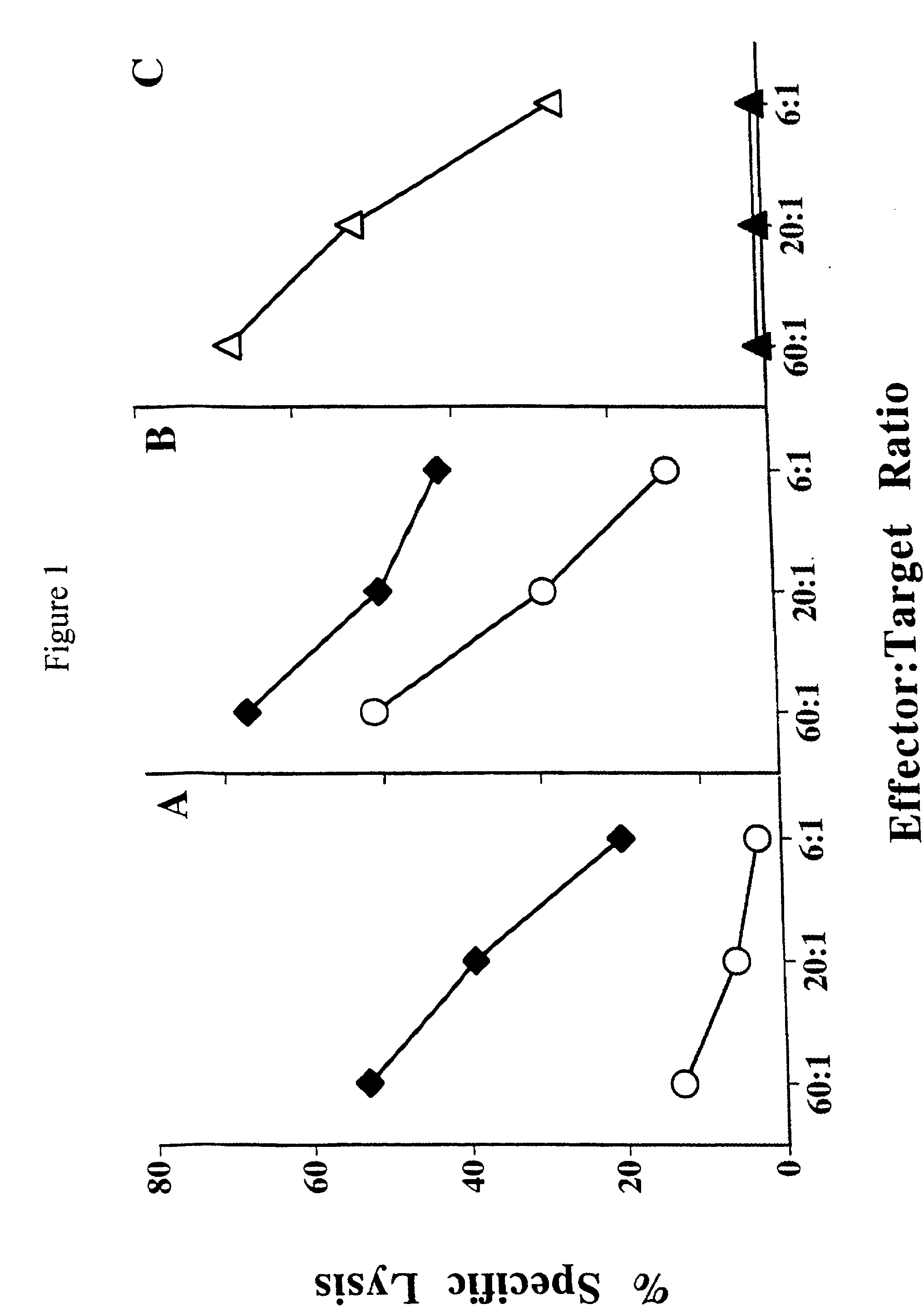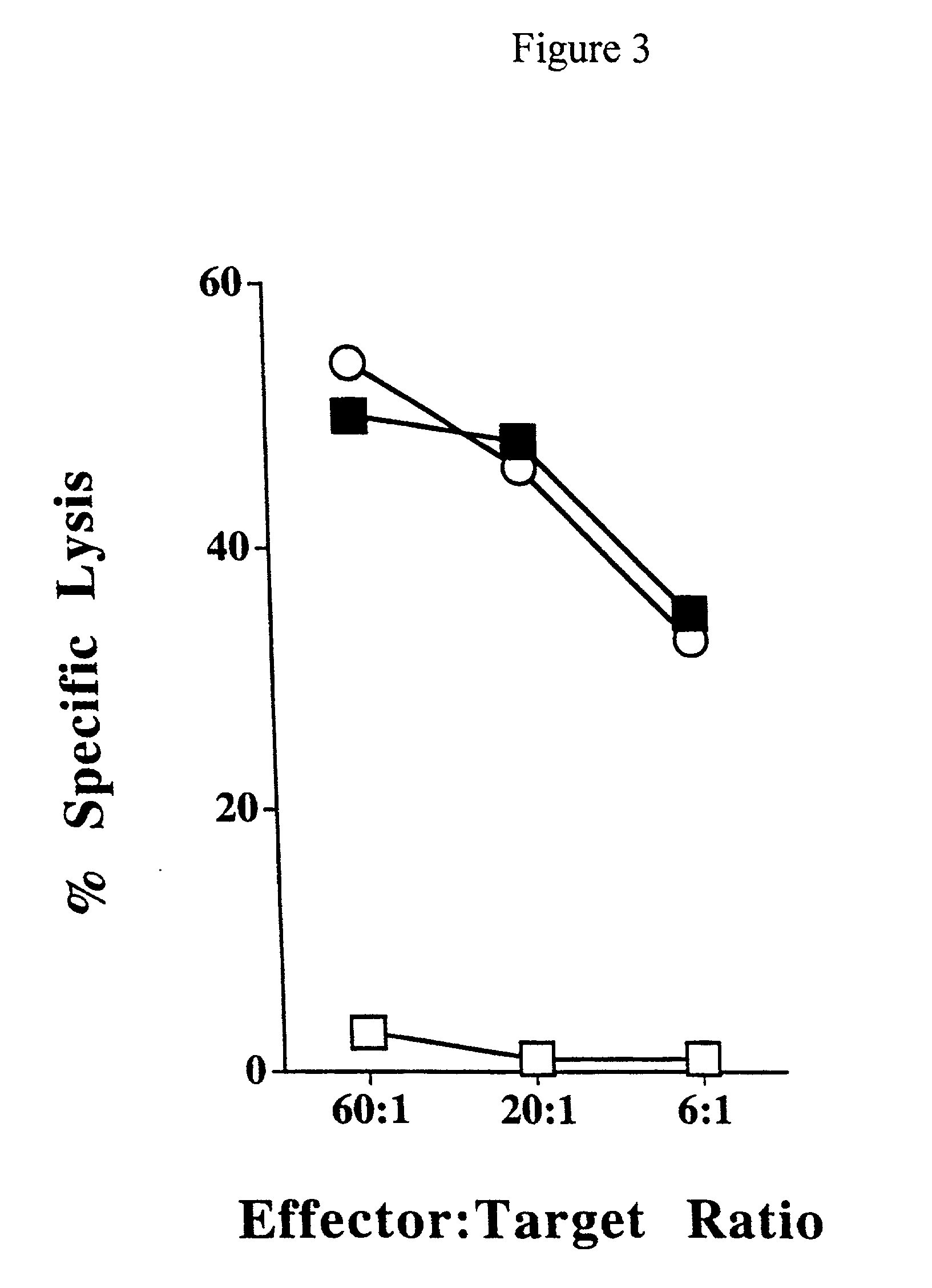Therapeutic applications of antigens or epitopes associated with impaired cellular peptide processing, e.g. expressed on rma-s cells transfected with a b7-1 gene
a technology of cellular peptide and antigen, which is applied in the field of therapeutic applications of antigens or epitopes associated with impaired cellular peptide processing, can solve the problems of escape variants, life-threatening meningitis, and the loss of antigen processing mechanisms of tumours
- Summary
- Abstract
- Description
- Claims
- Application Information
AI Technical Summary
Benefits of technology
Problems solved by technology
Method used
Image
Examples
example 1
[0103] RMA-S Cells transfected with B7-1 (CD80) elicit CTL that recognize non-transfected RMA-S cells.
[0104] B6 mice were immunized with three weekly s.c. injections of 10.sup.7 irradiated (100 Gray (Gy)) tumour cells. Tumours used were serially passaged as ascites cell lines in 4 Gy irradiated mice. The tumour cells were TAP-2 deficient ones, called RMA-S cells (derived from the Rauscher leukaemia virus-induced mouse T-cell lymphoma RBL-5 of B6 origin (44)), which were transfected with B7-1, i.e. 2.times.10.sup.6 RMA-S cells were incubated with 10 .mu.l LIPOFECTAMINE (Life Technologies Gaithersburg, Md.) and 1 .mu.g of the murine B7-1 gene cloned in a pSRIneo plasmid (45), a gift from Bristol Meyers Inc, Seattle, to Prof Klas Krre. Transfected cells were selected on GENETICIN (Life Technologies, Gaithersburg, Md.) at a concentration of 1 mg / ml. The 1% most positive fraction of the B7-1 expressing RMA-S cells were sorted on a FACS VANTAGE cell sorter (Becton Dickinson, Mountain View...
example 2
[0108] CTL recognition requires the presence of MHC class I molecules and the absence of TAP in the target cell.
[0109] A TAP-2 transfectant of RMA-S (RMA-S.TAP2 cells, also referred to as RMA-S II 5.9 cells, were derived by transfection of RMA-S with the murine TAP-2 gene (46)) was virtually resistant to lysis by RMA-S.B7-1 elicited CTL (FIG. 2A) as in Example 1. This indicated that the epitopes were recognized preferentially in cells devoid of TAP expression. In line with this, Con A blasts from TAP1 - / - mice were highly sensitive to lysis, whereas Con A blasts from B6 mice were resistant to lysis. Con A blasts from TAP1 / .beta..sub.2m - / - (double mutant) mice were resistant to lysis, suggesting an MHC class I dependence in the CTL recognition of epitopes (FIG. 2B).
[0110] Indeed, the human TAP-deficient cell line T2 transfected with H-2K.sup.b was sensitive to lysis by RMA-S.B7-1 elicited CTL, while non-transfected T2 cells were resistant (FIG. 2C). Taken together, these results ind...
example 3
[0111] TAP1 - / - splenocytes elicit CTL that recognize TAP1 - / - Con A blasts and RMA-S tumour cells.
[0112] As shown above, CTL elicited by RMA-S.B7-1 killed TAP1 - / - Con A blasts. Accordingly, immunization of B6 mice with splenocytes from TAP1 - / - mice yielded cytotoxic cells that efficiently lysed TAP1 - / - Con A blasts and RMA-S tumour cells while B6 Con A blasts and RMA-S.TAP2 were killed at markedly reduced levels (FIG. 3; data not shown). The killing of the TAP-deficient cells was also seen with effectors from mice depleted of NK (natural killer) cells (data not shown). B6 mice were immunized with two weekly s.c. injections of 50.times.10.sup.6 irradiated (20 Gy) spleen cells.
PUM
 Login to View More
Login to View More Abstract
Description
Claims
Application Information
 Login to View More
Login to View More - R&D
- Intellectual Property
- Life Sciences
- Materials
- Tech Scout
- Unparalleled Data Quality
- Higher Quality Content
- 60% Fewer Hallucinations
Browse by: Latest US Patents, China's latest patents, Technical Efficacy Thesaurus, Application Domain, Technology Topic, Popular Technical Reports.
© 2025 PatSnap. All rights reserved.Legal|Privacy policy|Modern Slavery Act Transparency Statement|Sitemap|About US| Contact US: help@patsnap.com



